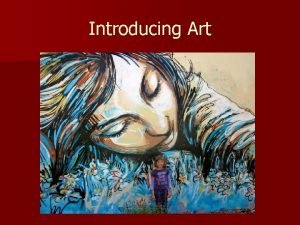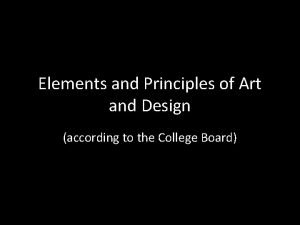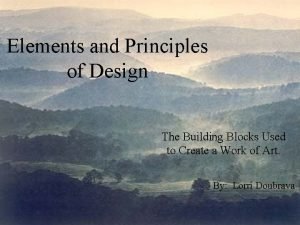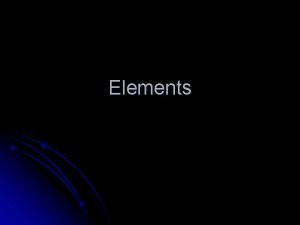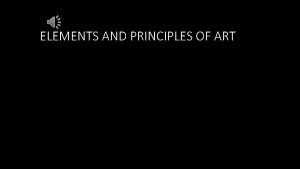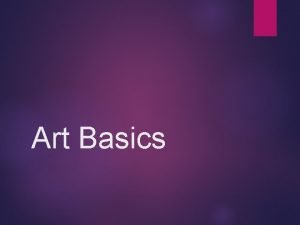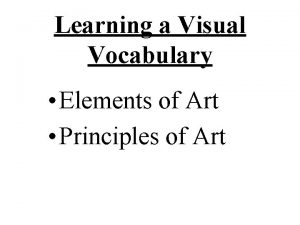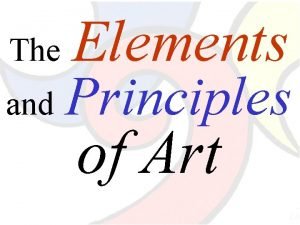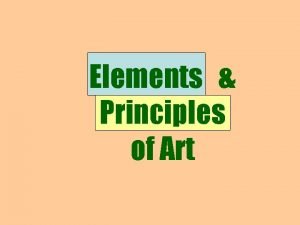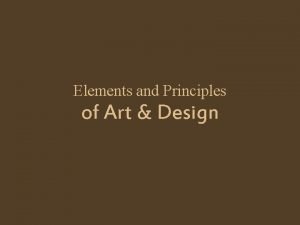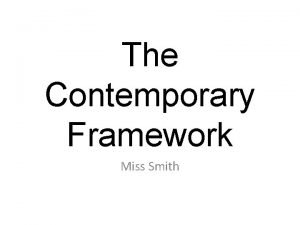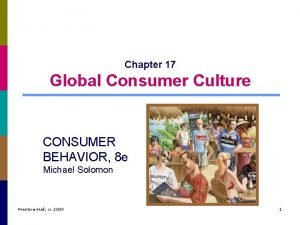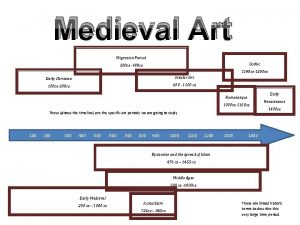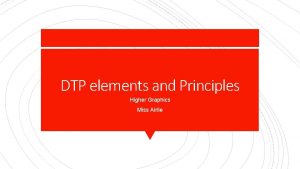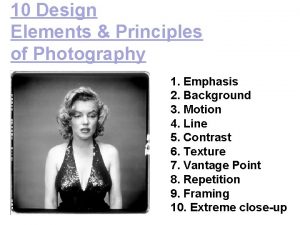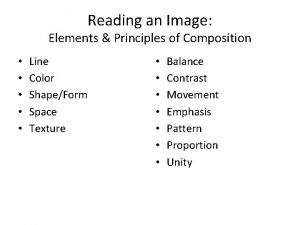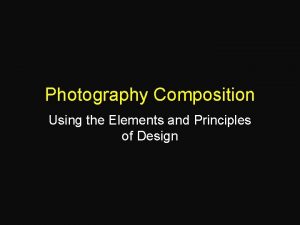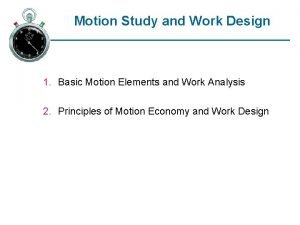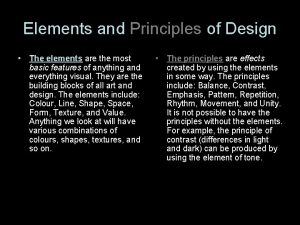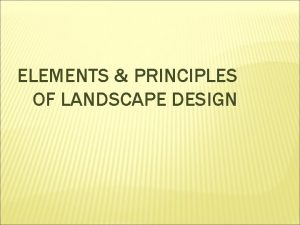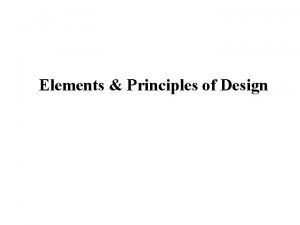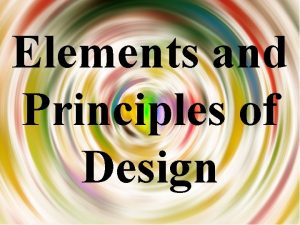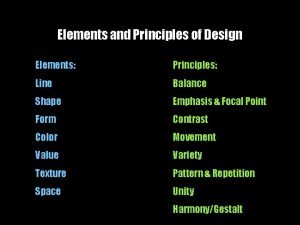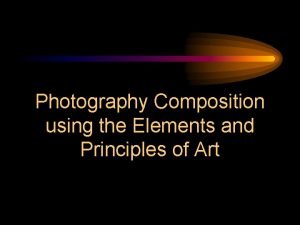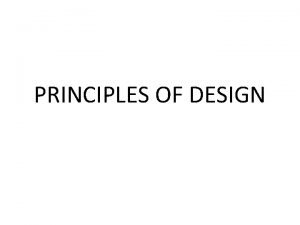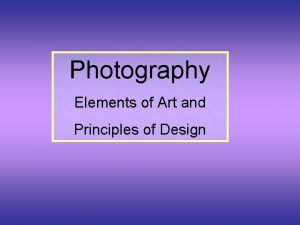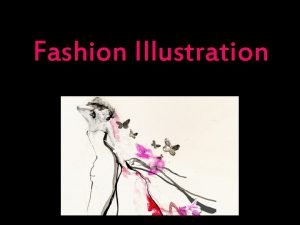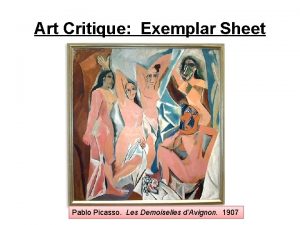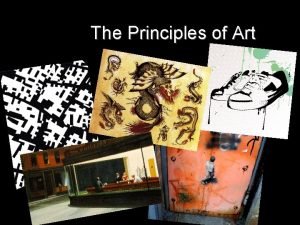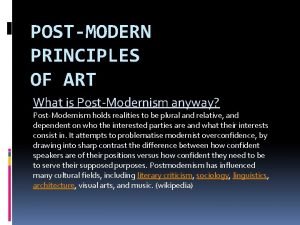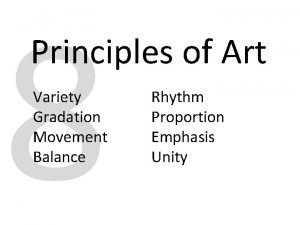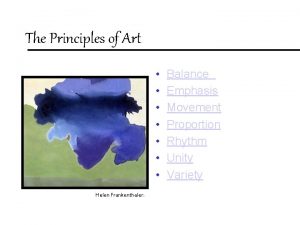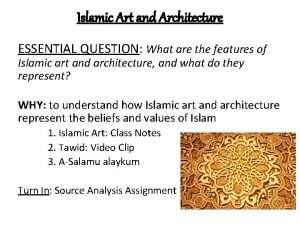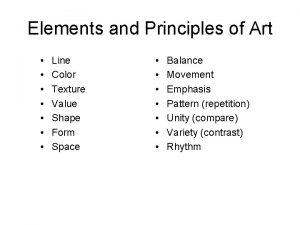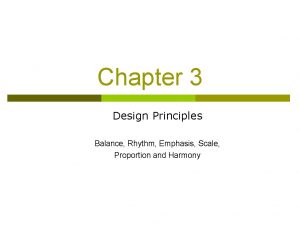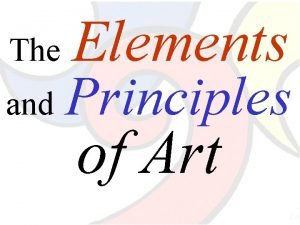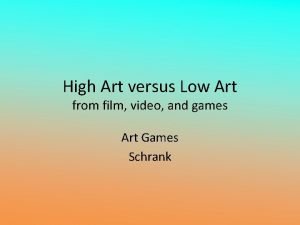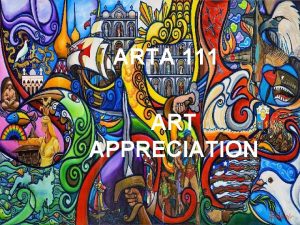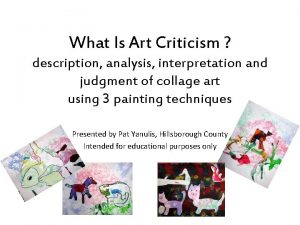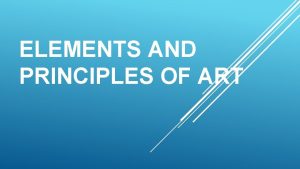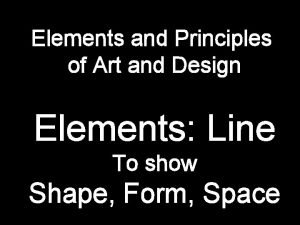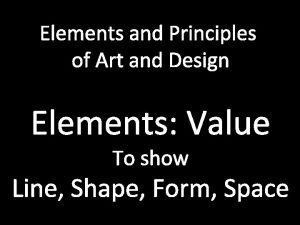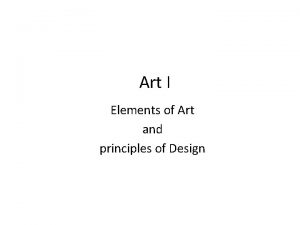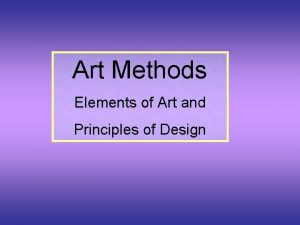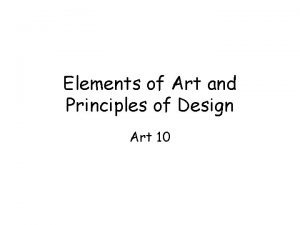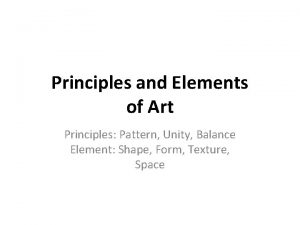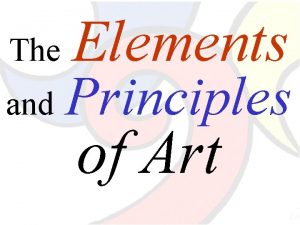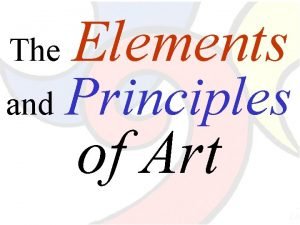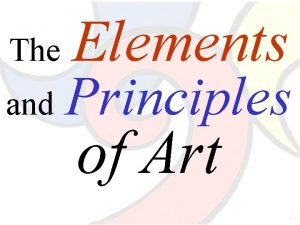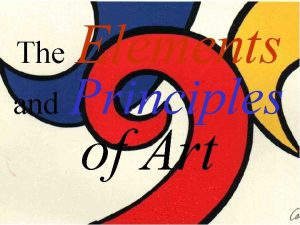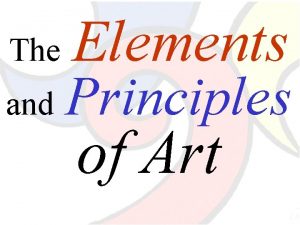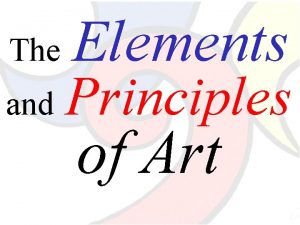The and Elements Principles of Art The Elements





















































- Slides: 53

The and Elements Principles of Art

The Elements of Art The building blocks or ingredients of art.

LINE A mark with length and direction. A continuous mark made on a surface by a moving point. Ansel Adams Gustave Caillebotte



Pablo Picasso

VALUE The lightness or darkness of a color. MC Escher Pablo Picasso

Value Scale

High Key Cezanne

Low Key Rick Amor

SHAPE An enclosed area defined and determined by other art elements; 2 -dimensional. Joan Miro

Gustave Caillebotte

Organic Shape: found in nature, free form, irregular

Geometric Shape: precise, mathematical

SPACE The distance or area between, around, above, below, or withings. Robert Mapplethorpe Claude Foreground, Monet Middleground and Background (creates DEPTH) Positive (filled with something) and Negative (empty areas).


TEXTURE The surface quality or "feel" of an object, its smoothness, roughness, softness, etc. Textures may be actual or implied.

Cecil Buller


FORM A 3 -dimensional object; or something in a 2 -dimensional artwork that appears to be 3 -dimensional. For example, a triangle, which is 2 -dimensional, is a shape, but a pyramid, which is 3 -dimensional, is a form. Jean Arp Lucien Freud

Form • Perceived through the interaction of light and an object • Gives the illusion of realistic depth • Organic or Geometric

Organic Form


The appearance of form can be created on a flat surface by using a variety of drawing techniques: blending, crosshatching, stippling, etc.

Geometric Form

COLOR Consists of Hue (another word for color), Intensity (brightness) and Value (lightness or darkness). Alexander Calder Henri Matisse



Color Value • Tints: Adding white, getting lighter • Shades: Adding black, getting darker

Color Intensity • Color purity • Mixing a complement dulls the intensity of a color. Monet



Split-Complementary Color Scheme • Combination of one color plus the colors on each side of its complement • Offers more flexibility than straight complementary color scheme.

The Principles of Design What we use to organize the Elements of Art, or the tools to make art.

B A L ANC E The way the elements are arranged to create a feeling of stability in a work. Alexander Calder

Symmetrical Balance The parts of an image are organized so that one side mirrors the other. Leonardo Da. Vinci

Asymmetrical Balance When one side of a composition does not reflect the design of the other. James Whistler

Radial Balance parts radiate from the center in all direction

EMPHASIS The focal point of an image, or when one area or thing stand out the most. Jim Dine Gustav Klimt

Tabitha Seaton

A regular repetition of elements to produce the look and feel of movement. Marcel Duchamp RHYTHM RHYTHM and MOVEMENT

Vincent Van. Gogh

UNITY When all the elements and principles work together to create a pleasing image. Johannes Vermeer

PATTERN and Repetition Gustav Klimt Repetition of a design.

Contrast Visual differences. Differences in line, shape, textures, colors, size, etc. The use of contrast makes a work of art more visually interesting. • Contrast and variation can create a center of interest (emphasis) to attract the viewer’s eye.

HIGH CONTRAST A large difference between two things to create interest and tension. Ansel Adams Salvador Dali

LOW CONTRAST A small difference between two things.

The use of differences and change to increase the visual interest of the work. V AR Marc Chagall IE T Y

Harmony The repetition of an element to create unity. Created through: • Repetition • Rhythm • Pattern

Two Types of Harmony • Ordered • Random

Ordered Harmony • Specific Placement (i. e. a new box of crayons)

Random Harmony • Random Placement (a dropped box of crayons)

 The actual surface feel of the simulated appearance
The actual surface feel of the simulated appearance The relative thickness or thinness of a line is known as
The relative thickness or thinness of a line is known as Elements and principles of art
Elements and principles of art Elements and principles of art
Elements and principles of art Principles of art movement
Principles of art movement Line shape form color texture space
Line shape form color texture space Elements of theater
Elements of theater Visual vocabulary art
Visual vocabulary art What is principle of art
What is principle of art Elements principles of art
Elements principles of art Elements principles of art
Elements principles of art Element and principles of art
Element and principles of art Art interpretation examples
Art interpretation examples Global consumer culture positioning example
Global consumer culture positioning example What is the purpose of a flying buttress?
What is the purpose of a flying buttress? The mass or general outline of a hairstyle
The mass or general outline of a hairstyle Hair design
Hair design Transition in floral design
Transition in floral design Principles of design
Principles of design Elements of interior design ppt
Elements of interior design ppt Has an immediate and profound effect on a design
Has an immediate and profound effect on a design Dtp elements
Dtp elements Design elements in photography
Design elements in photography Elements and principles of composition
Elements and principles of composition Elements and principles in photography
Elements and principles in photography A therblig is a basic motion.
A therblig is a basic motion. Ci elements
Ci elements Elements and principles of hybridity
Elements and principles of hybridity Design elements and principles of the universe
Design elements and principles of the universe Value and focus in art
Value and focus in art Scale and proportion in architecture
Scale and proportion in architecture Elements and principles of landscape design
Elements and principles of landscape design What are the elements and principles of design
What are the elements and principles of design What are the elements and principles of design
What are the elements and principles of design Visual elements and principles of design
Visual elements and principles of design Gradated rhythm
Gradated rhythm Unity
Unity Banjo lesson painting
Banjo lesson painting Elements and principles of photography
Elements and principles of photography Elements and principles of design fashion
Elements and principles of design fashion Les demoiselles d'avignon elements and principles
Les demoiselles d'avignon elements and principles Principles of art balance definition
Principles of art balance definition Robert rauschenberg postmodernism
Robert rauschenberg postmodernism Postmodern principles
Postmodern principles 8 principles of design
8 principles of design It is a movement in which some elements recur regularly.
It is a movement in which some elements recur regularly. Define islamic art
Define islamic art Principles of art line
Principles of art line Design principles balance
Design principles balance Principle of art
Principle of art Introduction of art appreciation
Introduction of art appreciation High art vs low art
High art vs low art Arts that are primarily seen and occupy space
Arts that are primarily seen and occupy space Art analysis vs art interpretation
Art analysis vs art interpretation
